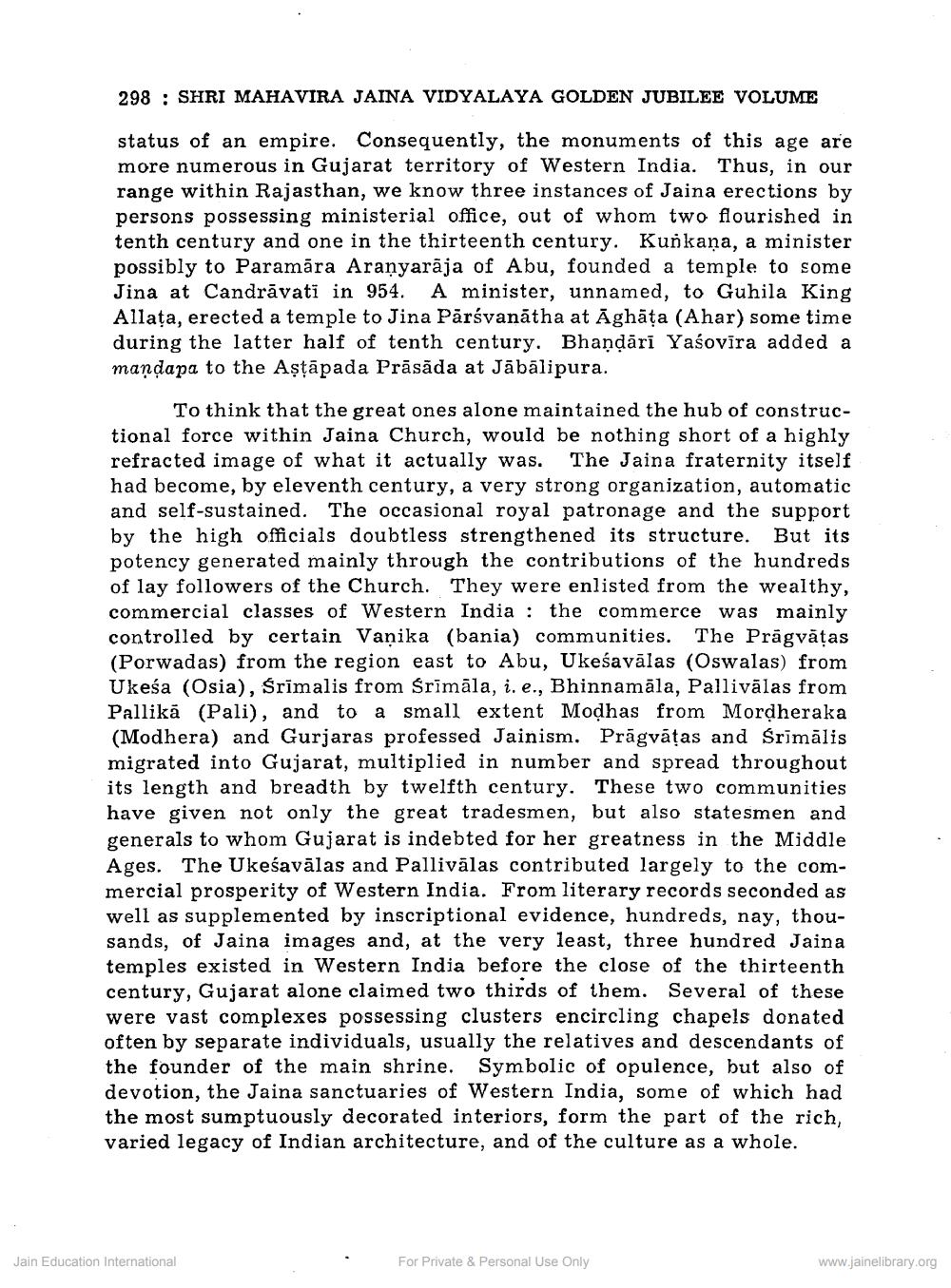Book Title: Some Early Jaina Temples in Western India Author(s): M A Dhaky Publisher: Z_Mahavir_Jain_Vidyalay_Suvarna_Mahotsav_Granth_Part_1_012002.pdf and Mahavir_Jain_Vidyalay_Suvarna_ View full book textPage 9
________________ 298 : SHRI MAHAVIRA JAINA VIDYALAYA GOLDEN JUBILEE VOLUME status of an empire. Consequently, the monuments of this age are more numerous in Gujarat territory of Western India. Thus, in our range within Rajasthan, we know three instances of Jaina erections by persons possessing ministerial office, out of whom two flourished in tenth century and one in the thirteenth century. Kunkana, a minister possibly to Paramāra Aranyarāja of Abu, founded a temple to some Jina at Candrāvati in 954. A minister, unnamed, to Guhila King Allata, erected a temple to Jina Pārsvanātha at Āghāța (Ahar) some time during the latter half of tenth century. Bhandari Yasovīra added a maņdapa to the Așțāpada Prāsāda at Jābālipura. To think that the great ones alone maintained the hub of constructional force within Jaina Church, would be nothing short of a highly refracted image of what it actually was. The Jaina fraternity itself had become, by eleventh century, a very strong organization, automatic and self-sustained. The occasional royal patronage and the support by the high officials doubtless strengthened its structure. But its potency generated mainly through the contributions of the hundreds of lay followers of the Church. They were enlisted from the wealthy, commercial classes of Western India : the commerce was mainly controlled by certain Vanika (bania) communities. The Prāgvātas (Porwadas) from the region east to Abu, Ukeśavālas (Oswalas) from Ukeśa (Osia), Śrīmalis from Srimāla, i.e., Bhinnamāla, Pallivālas from Pallikā (Pali), and to a small extent Modhas from Mordheraka (Modhera) and Gurjaras professed Jainism. Prāgvātas and Srimālis migrated into Gujarat, multiplied in number and spread throughout its length and breadth by twelfth century. These two communities have given not only the great tradesmen, but also statesmen and generals to whom Gujarat is indebted for her greatness in the Middle Ages. The Ukeśavālas and Pallivālas contributed largely to the commercial prosperity of Western India. From literary records seconded as well as supplemented by inscriptional evidence, hundreds, nay, thousands, of Jaina images and, at the very least, three hundred Jaina temples existed in Western India before the close of the thirteenth century, Gujarat alone claimed two thirds of them. Several of these were vast complexes possessing clusters encircling chapels donated often by separate individuals, usually the relatives and descendants of the founder of the main shrine. Symbolic of opulence, but also of devotion, the Jaina sanctuaries of Western India, some of which had the most sumptuously decorated interiors, form the part of the rich, varied legacy of Indian architecture, and of the culture as a whole. Jain Education International For Private & Personal Use Only www.jainelibrary.orgPage Navigation
1 ... 7 8 9 10 11 12 13 14 15 16 17 18 19 20 21 22 23 24 25 26 27 28 29 30 31 32 33 34 35 36 37 38 39 40 41 42 43 44 45 46 47 48 49 50 51 52 53 54 55 56 57 58
